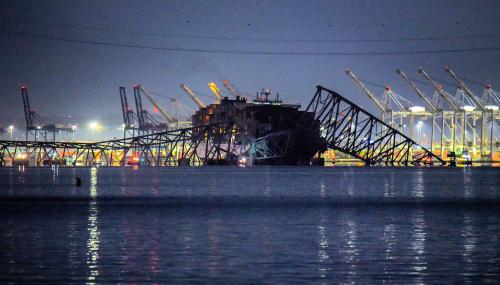Content from the Brookings Institution India Center is now archived. After seven years of an impactful partnership, as of September 11, 2020, Brookings India is now the Centre for Social and Economic Progress, an independent public policy institution based in India.
While the government has taken several steps in the right direction, these measures do not add up to a credible strategy to re-start infrastructure. Building up on action already taken, a strategy needs to be formulated around three dimensions.
The Background
For the past couple of years, there has been widespread and growing acceptance of the proposition that the Public Private Partnership (PPP) model for infrastructure development has not worked. The tangible signs of this are a large number of incomplete and stalled projects, which are doing nothing to enhance the economy’s infrastructure capacity and a massive build-up of non-performing assets (NPAs) on the balance sheets of the country’s banks. The first is a direct threat to accelerating growth and sustaining it at higher rates. The second reinforces the impact by making it more and more difficult for banks to finance ongoing business activity, let alone new investment. Any strategy to re-start infrastructure will have to address both stress points.
Acceptance and Response
It is clear from both government statements and actions that the nature of the problem has been recognized. The Economic Survey published by the Ministry of Finance prior to the Union Budget in February, highlighted the criticality of increasing public investment into infrastructure. The Budget acted on this premise by committing a larger amount of funds for investment, both overall and through a Rs. 20,000 crore commitment to a new entity, the National Infrastructure and Investment Fund (NIIF). This institution is expected to use its resource base to invest in the equity of existing infrastructure financing companies, enabling them to borrow from home and abroad. In turn, these funds can be used to both directly channel funds into stuck projects, bringing them that much closer to viability and, in appropriate situations, buying the assets from banks, easing the pressure on them from infrastructure NPAs and expanding their capacity to lend to other businesses.
The financial aspect of the government’s response has been accompanied by efforts to speed up clearances at the central government level, which, if everything goes smoothly, should speed up project implementation.
However, while the steps taken are certainly in the right direction, the question remains: do these measures add up to a credible strategy to re-start infrastructure? If not, what further actions need to be taken?
Next Steps
The answer to the first question is “no”. This implies two things. One, a strategy needs to be explicitly articulated. Two, actions that are consistent with that strategy need to be taken.
Building on the actions already taken, the strategy needs to be laid out along three dimensions.
- Priority: There certainly will not be the capacity to rescue all the over 300 projects that are in various stages of incompletion. A structure like the NIIF, will only enhance investible resources by about Rs. 1,00,000 crores, assuming a debt-equity ratio of 4:1. For this volume of resources to be used optimally, the projects that are to be financed need to be selected very carefully. The basic criteria that need to be used to prioritize projects should be based on the concept of “network externalities”, or in terms of another framework, “mission criticality”. These refer to the impact that early completion of a project will have on the productivity and efficiency of other components of the overall system. The NIIF must begin by identifying the most important projects based on these criteria and enable their rapid re-starting and completion.
- Ownership and Control: If a project qualifies for priority funding, the organizational structure within which it is being implemented needs to be assessed in terms of its capacity to meet the objectives of quick re-starting and completion. In cases where managerial capacity needs to be brought in from the outside to achieve these objectives, there should be no constraint on doing so. Promoters’ and shareholders’ interests need to be protected where possible and justified, but these must be subordinated to the larger public interest of early completion. In effect, a “going concern” bankruptcy model, which allows the project to be implemented while limiting stakeholder conflict, needs to be used to do this. This will require interventions both at the level of individual projects and at a system level to lay out criteria and processes.
- Transition: In the near term, the NIIF will have to work within the resource constraints imposed on it by fiscal considerations. In order to maximize the impact of its resource base, it will have to begin divesting from its projects as soon as possible. Typically, long-term private investors would be willing to invest into infrastructure projects when revenue streams are two or three years away. As revenue streams come closer, a wider range of investors will show interest. The NIIF will have to design an approach for divesting its equity stake in sequence as the project nears completion and investor appetite broadens. In effect, the NIIF becomes a “serial entrepreneur” for infrastructure projects.
One year into its term, the government has launched a number of initiatives, which reflect its overall development strategy. But, virtually all of them depend heavily on a massive expansion of infrastructure capacity and delivery. The government needs to coalesce around the financial and administrative elements that have already been put in place during the first year. The dimensions laid out above provide a means to think about and act on this huge challenge.


Commentary
Op-edRe-starting infrastructure
IndiaGov@365
May 6, 2015